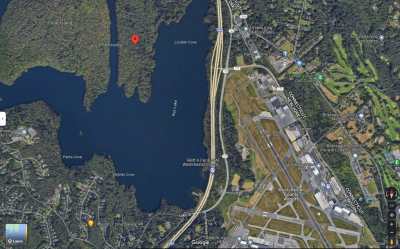NTSB Report: Small Plane That Crashed Had Hole in Crankcase

A hole found in the top of a crankcase may have caused the Jan. 19 small plane crash that killed two men less than two miles short of Westchester County Airport.
The National Transportation Safety Board (NTSB) released its preliminary report late last week about the doomed flight that saw a Beech A36, N19MT take off from Kennedy Airport about 5 p.m., about 16 minutes before the pilot first reported to the air traffic controller that the aircraft was having poor flight performance.
Pilot Boruch Taub and passenger Benjamin Chafetz, both from the Cleveland, Ohio area, were killed when the plane, trying to make an emergency landing at Westchester County Airport, struck treetops on New York City land adjacent to the Rye Lake Reservoir, part of the city’s watershed, and crashed into a heavily wooded area.
It took more than five hours before rescue crews could reach the plane in a remote area near the reservoir during a rainstorm. The report did not state whether weather also may have played a role in the crash.
“Examination of the engine revealed a hole in the top of the crankcase in-line with the No. 6 cylinder position,” the preliminary conclusion from the NTSB report read. “A deformed connecting rod cap with two fractured and entrapped connecting rod bolts was found inside the engine adjacent to the hole. The engine was retained for further examination. In addition, an engine monitor, a Stratus 3 ADS-B receiver, three portable electronic devices and two Garmin G5 electronic flight instruments were retained for potential data download.”
The report stated that seconds before 5:16 p.m., the pilot asked the air traffic controller if he could stop his altitude climb. Although there were no anomalies displayed on the aircraft’s instrumentation, at 5:18 p.m. Taub told the controller of a “dead cylinder” and requested permission to land at Westchester County Airport.
The pilot first declared an emergency at 5:21 p.m. when he was southwest of the airport and reported steadily dropping oil pressure. At 5:25 p.m. the pilot issued a “mayday” while losing altitude. He was then cleared for an emergency landing. The last contact with the pilot at 5:28 p.m. had the plane at only 800 feet and 1.6 miles from the airport before it dropped off radar.
According to the report, “(f)resh oil was noted on the bottom of the fuselage beginning just aft of the wing root and extending to the tail cone. In addition, fresh oil was observed at the outlet of the lower crankcase breather line.”
The flight was bound for the Cuyahoga County Airport in Richmond Hills, Ohio.
Examination of the accident site area revealed that the airplane first impacted a tree about 100 feet above ground level, the NTSB reported. There were multiple contacts with trees at slightly decreasing heights until the main wreckage came to rest about 250 feet from the initial tree strike, the report also stated.
It is expected that the NTSB will take at least another year to issue its final report.

Martin has more than 30 years experience covering local news in Westchester and Putnam counties, including a frequent focus on zoning and planning issues. He has been editor-in-chief of The Examiner since its inception in 2007. Read more from Martin’s editor-author bio here. Read Martin’s archived work here: https://www.theexaminernews.com/author/martin-wilbur2007/
